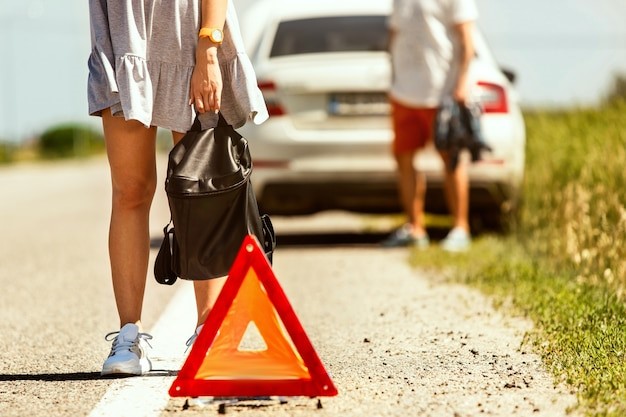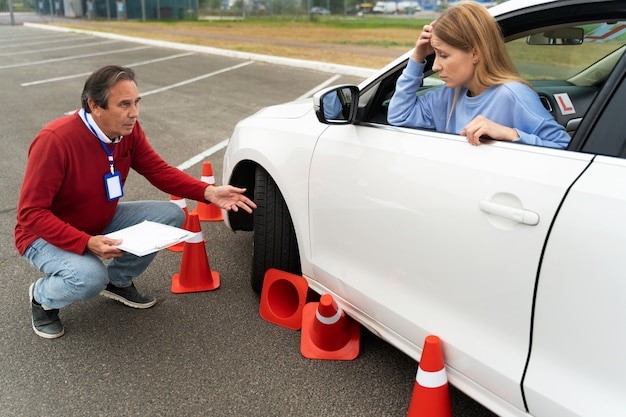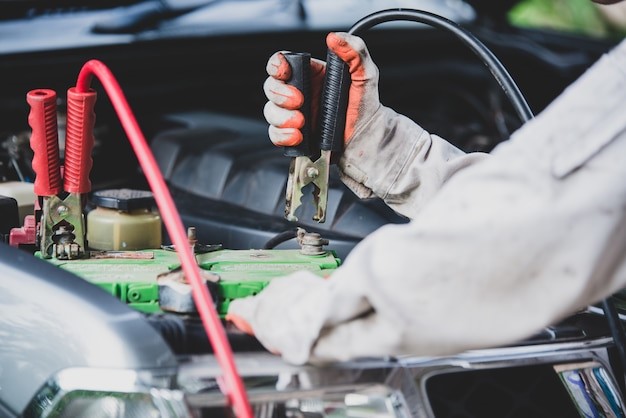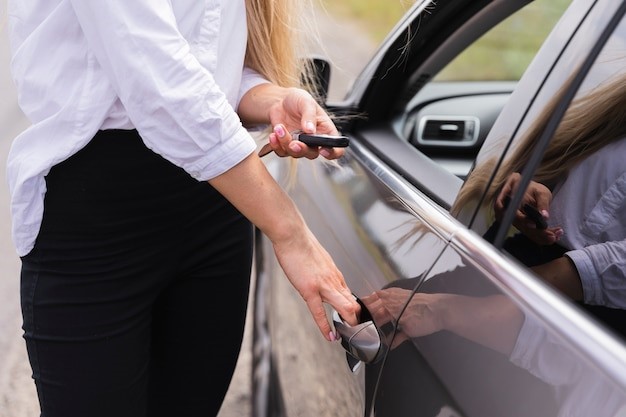A flat battery can get worse, especially when you are in a hurry. Maybe you are stuck with a dead battery. All you need to know is how to jump-start a car. The thing is, you don’t need a mechanic to fix the issue. You can jumpstart your car and be back on the road in minutes. In this guide, we’ll walk through methods to jump-start start car.
How Does Jump Starting Work?
Works of jump-starting are the transfer of energy of a fully charged battery (or handheld jump time) to the dead battery. This short burst of power enables your car to start and enables the alternator to do the charging of the battery.
Common Jumpstart Methods
Using Jumper Cables
- Using jumps, a dead battery should be connected to a working one.
- Use proper sequence red- positive, black- negative or grounded metal.
Using a Portable Jump Starter
- The compact battery packs to jumpstart your car without the use of another car.
Push Start (Manual Cars)
- In manual transmission cars, push the car, engage the clutch and then release.
Solar or Battery Chargers
- Solutions to emergency cases of battery failure or emergency situations.
What You Need to Jumpstart a Car
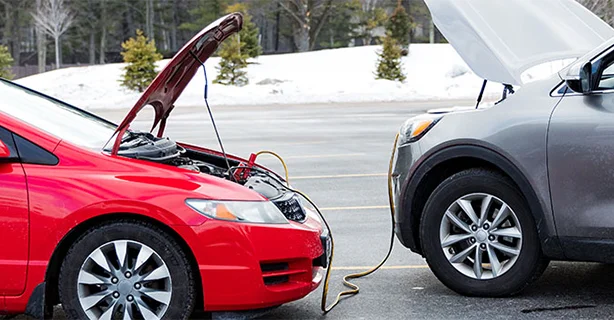
Jumpstarting your car with the right tools helps you avoid damage and stay safe while working near the battery. Get your car running again with our expertise. We’ve got you covered whether you’re using a portable battery pack, jumper cables, or even need help. Tools You’ll Need:
- A set of jumper cables
Jumper cables come in different power levels. Smaller cars use high numbered cables (10 or 12). One black cable (negative) and one red cable (positive).
- Fully charged battery
Another car with a full battery can be energy efficient. You’ll use this car to help power yours.
- Safety gear
You should use Gloves and goggles. It is a smart choice to protect your hands and eyes. Safety should be your priority.
Once you have everything ready and it’s safe to begin, you can follow the jump-start steps to bring your car back to life. Want me to add a safety tips section or list different methods after this?
How to Jump-Start Your Car: A Step-By-Step Guide
A dead car battery can happen anytime. However, you can save your time and stress, whether it’s a cold morning or you’re running late. But you should know how to jump-start your car. Here is the step-by-step guide to prevent accidents and protect both you and your car.
Note: First, check the following:
- Do not attempt to jump-start your vehicle if battery leakage or damage is present.
- Keep all batteries free from flames and cigarettes while working on them.
- You should maintain a safe distance between the battery region and all jewelry and loose clothing, and metallic items.
- Remove the key from the ignition slot before beginning the engine start.
After performing all necessary checks, you can start the process.
Step 1: Park the cars close
You can jumpstart a car by bringing the working vehicle close to the one that won’t start.
- Line them up nose to nose
- Jumper cables can reach both batteries.
- Turn off the working car and open the hoods on both vehicles.
- Find the batteries.
Note: Most batteries are under the hood, but some might be in the trunk. Check your car’s manual if you are unfamiliar with it.
Step 2: Find the battery terminals
As a driver, you should be familiar with the battery terminals.
- Look for the positive (+) and negative (–) signs on the battery terminals.
- The positive terminal usually has a red cover wire.
- The negative terminal usually connects to a black wire.
- Match the jumper cable colors to these terminals (red to positive, black to negative).
Note: Some cars have special jump points under the hood instead of the battery itself. The owner’s manual will help you find the right spot.
Step 3: Connect the jumper cables
The next step is to connect the jumper cables efficiently.
- Keep the clamps from touching each other.
- Take one red clamp and connect it to the positive terminal. Make sure it grips the metal well.
- Set the black clamp aside on a plastic part to avoid contact.
- Now take the other end of the cable.
- Connect its red clamp to the positive terminal of the good battery.
- Then connect the black clamp to the negative terminal of the good battery.
- Attach the clamp securely.
Note: Don’t connect the last black clamp to the dead battery. Instead, find an unpainted metal part like a bolt under the hood. This reduces the chance of sparks or damage.
Step 4: Start the working car
Now, it’s time to start the car. Before it, make sure the cables are clear from fans or belts.
- Start the car with a good battery and let it run for a few minutes.
- This charges the dead battery a bit.
- Then try starting the car with the dead battery.
Note: Wait a bit longer and try again if it doesn’t start. Otherwise, need to replace it with another part or battery.
Step 5: Remove the cables
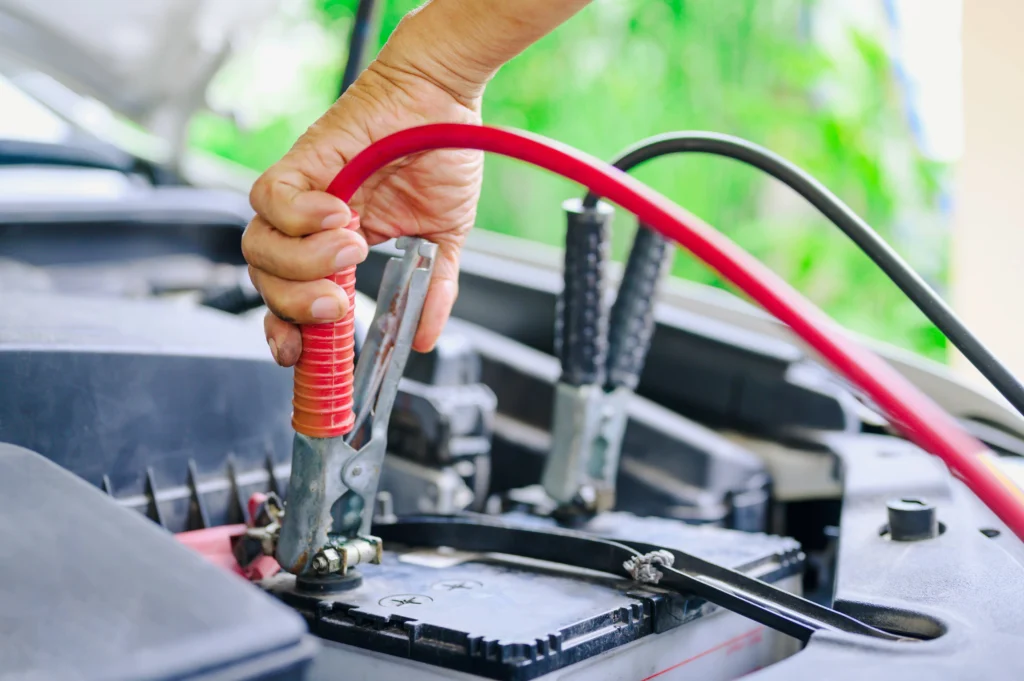
Remove the cables, once your car starts. Keep it running and remove the cables in the reverse order.
- First, take off the black clamp from the metal part under the hood.
- Then remove the red clamp from the dead battery.
- Place the clamps apart on the ground.
- Next, remove the red and then the black clamps from the good battery.
Note: If your car dies again after a short drive, jump-starting won’t fix it for good. Visit a mechanic or get your battery replace to avoid being stuck again.
Safety Tips for Jump-Starting Your Car
Prior to any jump-start, it is necessary to observe correct safety measures. When using car batteries, carelessness may cause serious damages or injuries, and therefore these steps should be taken carefully in order to prevent risks to yourself or your car:
1. Wear Protective Gear
Use of gloves and safety goggles all the time. The gloves prevent acid on the hands or sparks, and eyewear stops the possibility of battery acid or debris getting into the eye. Burns or even serious injury, can be caused even by a small spill.
2. Avoid Damaged Batteries
There should be no attempt to jump-start a leaking, crashed, or frozen battery. Spilt acid is potentially dangerous and a damaged or frozen battery is likely to explode during stress. Before using it, it is always good to check the battery, in case any damage is visible.
3. Keep Flames and Sparks Away
Batteries yield gas, hydrogen gas, which is highly flammable. Let there not be open flames, sparks, cigarettes, or welding equipment around as you jump-start your car. A little spark may lead to high explosions
4. Remove Jewelry and Loose Clothing
The battery terminals could also become shorted and/or burned or electrified as could rings, bracelets, necklaces or any loose clothing. Metallic accessories should be taken off and all loose clothing before starting.
5. Maintain Proper Cable Handling
Be sure to keep the jumper cables separate and not in contact with belts, fans or pulleys, which are moving engine parts. Improper installation may form sparks or destroy the electrical system of your car. When attaching clamps, do it correctly and firmly always.
6. Work in a Well-Ventilated Area
The gases produced inside the battery can collect in pockets thus presenting a greater possibility of exploding. It is always advisable to start your car outdoors or in a well flowing garage with the doors open.
7. Check Vehicle Manuals
Modern cars, or hybrids particularly, have a jump-start procedure. In order to prevent damage to delicate electronics, consult the owner manual prior to a jump-start.
8. Keep a Safe Distance
Hold yourself aside as you connect and turn on the battery. This decreases the chances of getting injured in case a cable gives way or there is a reaction on the battery which is unexpected.
Conclusion
A dead battery can be a big problem. But you can handle it yourself with the right steps. If you know how to jump-start your car, you can get rid of mental illness and stress. Follow the guidelines and always check for safety first, whether you’re using jumper cables, a jump starter, or other methods.
FAQs
Jump-starting is secure for batteries in good condition. The process places minimal strain on both battery and alternator components. Driving your vehicle will automatically recharge your battery. The incorrect attempt of this process can harm your car especially its electrical components.
Here’s a simple step-by-step way to do it safely:
Turn off both cars.
Connect the red cable to both positive terminals of the batteries.
Attach the black wire to the negative post of the functioning battery.
Secure the black clamp to the engine metal section of the dead car.
Begin by starting the functional vehicle before starting the non-operational vehicle.
To stop the vehicle from starting, you should disconnect cables starting from the most recent connection.
Yes, it can—if done wrong. The electronics in modern vehicles remain sensitive to damage, which can occur when jump-starting is performed incorrectly. The correct steps are vital because improper handling might damage car electronics; thus, seeking professional assistance becomes necessary when unsure.
Contact All 4 One Transportation Services & Roadside Assistance—If you ever need help on the spot.

